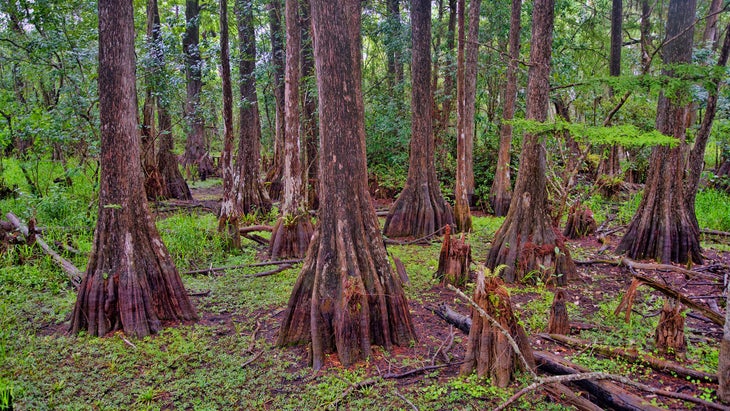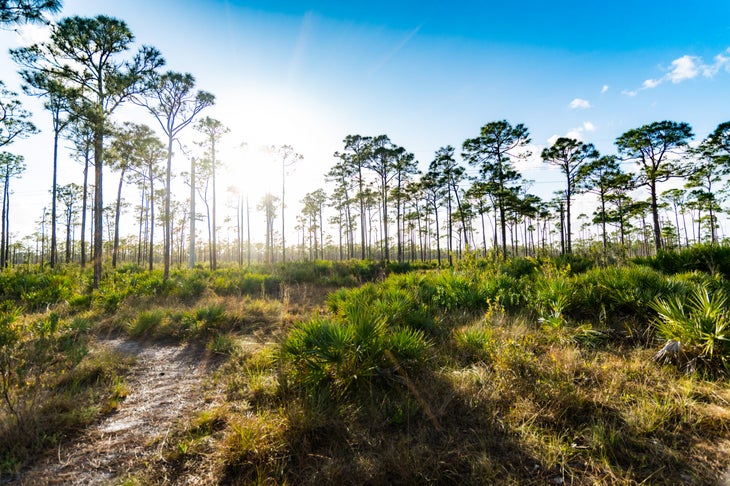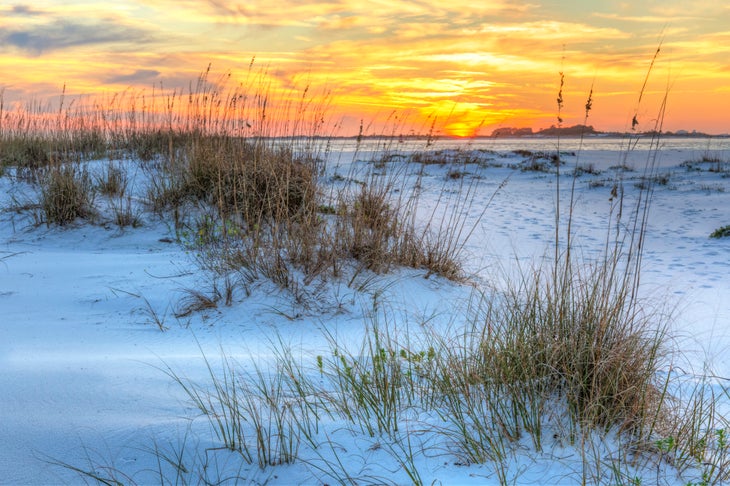Products You May Like
Receive $50 off an eligible $100 purchase at the Outside Shop, where you’ll find gear for all your adventures outdoors.
Sign up for Outside+ today.
There’s a lot more wilderness, and a lot more ecosystems to hike through, in Florida than most people think. Case in point: The Florida Trail, which crosses more than 1,500 miles of beaches, swamps, pine forests, and grasslands. Only about 30 people attempt to thru-hike the Florida Trail every year, compared to the thousands who head for the Appalachian Trail and Pacific Crest Trail; if you want solitude, wildlife, and bragging rights, this is an ideal trail for you. As a bonus, the Florida Trail is open year-round, with no concerns about snow at its maximum elevation of 300 feet.
The 1,500-mile Florida National Scenic Trail stretches from the mangrove wetlands of Big Cypress National Preserve to the white sand beaches of Gulf Island National Seashore. Most thru-hikers start in the south, where they can get the hottest part of the trail done first. The first 24.6 miles heads through subtropical cypress swamp, pine-dotted islands,and saw palmetto prairie. Camp at Seven Mile Camp and listen for wild turkeys, hawks, and the distinctive scream of a bobcat.
The next section climbs to a dryer section of Big Cypress National Preserve, with views down into the lush swamp. There are three campsites along this stretch: Carpenter Camp, Panther Camp, and CCC Camp. The next 40.3 miles travel through similar terrain in the Seminole Tribe Reservation. From there, head to Lake Okeechobee, one of the largest lakes in the country at 730 square miles. This section of the trail follows canals and dikes along the water. Shade can be hard to find here, but the panoramic views of the lake (home to herons, sandhill cranes, and meadowlarks), palm hammocks, and sugarcane fields make up for it. Pick either the east or the west route along the lake; both are equally worth the walk. Both lake routes add up to around 90 miles.
After Okeechobee, head into the jungle of Marshall Swamp, where the floodplain of the Silver River runs 32 miles through sandy islands of pines, hardwood forest, and swamps filled with enormous trees and ferns. The next 40 miles mixes singletrack, bike paths, and roadwalking through old ranches, oak forest, and historic towns. Crossing into Withlachoochee State Forest, the trail climbs into sandhills scattered with campsites. Wildlife sightings are nearly guaranteed along this 30-mile stretch; deer are the most common, but Florida panthers live here, too.

From there, the trail splits temporarily into east and west corridors. For the western section, return to riverine swamp and hardwood forests for the next 50 miles, keeping an eye out for armadillos, bobcats, foxes, and alligators. The next section, in the eastern part of Green Swamp, where four of Florida’s major rivers start. Some of the 25 miles in the swamp often require wading through cypress floodplains, so come prepared. The next 50 miles are a roadwalk with no designated campsites, though there are several motels. For the eastern section, leave the roads for the woods again for 34 miles of parks and preserves, which are home to a 2,000-year-old cypress tree and a large population of black bears. The next section mixes roads and trails again for 30 miles, passing through some of the state’s biggest cypress trees. Bald eagles nest along this stretch, too. From there, return to wilderness for 35 miles. In the spring, wild irises bloom through the pine and cypress woods and along the edges of the swampier areas. Switch to rail trails for the following 37.7 miles, where the Allen Broussard Conservancy offers one of the few campsites along the route with a shower. Head to the wet prairies surrounding Lake Kissimmee, which are critical wintering grounds for whooping cranes and sandhill cranes. These 53 miles can be fairly exposed, so be prepared for sun, heat, and storms. Kissimmee Prairie Preserve State Park, near the end of the section, became Florida’s first Dark Sky location in 2016.
The two routes join up again when the trail leaves the prairie to follow the Kissimmee River for 33 miles. Hop from there over to the Suwanee River, one of the most up-and-down sections of the trail. The 71 miles that parallel the Suwanee include several waterfalls, a whirlpool, and four primitive campsites. From the Suwanee, head into longleaf pine forest, which forms a prime habitat for the Florida black bear, for 25 miles, then cross back to the Suwanee and the whitewater at Big Shoals. The next section heads onto rural roads and through pine forest for 23 miles. If you hike this region in February, listen for artillery: the Civil War Battle of Olustee is re-enacted here every year. Head into drier sandhills for the next 70.2 miles, traversing the central highlands of Florida. More northern tree species start appearing here, including poplars and dogwoods. Check out flowering azaleas along the trail in the spring. The next 80 miles traverse Ocala National Forest, where the first blazes for the Florida Trail were painted. This section remains in wooded uplands home to black bears, armadillos, and Easter snakes. You can camp anywhere in the Ocala, but during hunting season sticking to established sites is recommended. The last 339 miles of trail head into the Florida Panhandle for the highest points and most climbing of the trail, including several miles wandering through mountain laurel and wild azalea, pine forests that give way to wildlife-filled estuaries, and finally 25 miles of spectacular beach walking in Gulf Islands National Seashore.

Florida Trail Skills: Follow the Blazes
Most of the Florida Trail is marked by orange blazes, with each blaze within sight of the next. A double blaze indicates a turn, but the way the double blaze is made isn’t consistent throughout the trail: In some spots the upper blaze is offset to indicate the direction of the turn, but in others it isn’t. You should be able to see the next blaze from the turning point, though, so look carefully before continuing. Don’t rely only on blazes, especially in roadwalking sections: Bring a map and compass and, if desired, a GPS unit, and know your route before you leave.

Gear for the Florida Trail
The biggest concern on the Florida Trail is water, whether you’re wading through it in a cypress wetland or caught in a thundershower in the open. Bring waterproof layers, both a jacket and pants, as well as gaiters and waterproof boots. Extra socks are advisable, too, in case the water is too high or the waterproofing for your feet fails. Though winter temperatures can still reach 80 degrees, they can also occasionally drop below freezing; make sure to throw in a light insulating layer as well. Your tent should have a durable, proven rainfly.
Permits for the Florida Trail
The Florida Trail Association requires that thru-hikers notify them of their plans a minimum of 30 days before starting their hike. While most of the trail does not require permits, a few sections—including Big Cypress National Preserve and the Seminole Tribe Reservation—do require permits for travel or camping. Check the Florida Trail Association Data Handbook for the latest information on what spots require permits or reservations.
Most thru-hikers start the Florida Trail in winter, particularly in January, and take two to three months to complete the entire route going south to north. This keeps the entire thru-hike in Florida’s driest season and avoids the fall hunting season as well. You can dayhike, section hike, or thru-hike the Florida Trail any time of year, but during hunting season make sure to bring bright clothes and make noise. The summers in Florida are very hot and severe thunderstorms are common: If you hike during the summer, make sure you have sunscreen and a sunhat, waterproof shell layers, and a bailout plan if the weather becomes too much of a problem.
